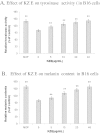Kaliziri extract upregulates tyrosinase, TRP-1, TRP-2 and MITF expression in murine B16 melanoma cells
- PMID: 24884952
- PMCID: PMC4091957
- DOI: 10.1186/1472-6882-14-166
Kaliziri extract upregulates tyrosinase, TRP-1, TRP-2 and MITF expression in murine B16 melanoma cells
Abstract
Background: Kaliziri extract (KZE) is a traditional Uyghur medicine (TUM), used by traditional hospitals in China as an injection for treatment of vitiligo for more than 30 years. Clinical application has shown that this medicine has obvious therapeutic effects. However, its phytochemical analysis and mechanism have not been examined.
Methods: KZE was extracted from seeds of Kaliziri [Vernonia anthelmintica (L.) Willd.] in ethanol-water (80:20, v/v), its components were identified by LC-MS/MS, and the signaling pathway of melanin synthesis in KZE treated murine B16 melanoma cells was examined by western blotting.
Results: Liquid chromatography-mass spectrometry analysis confirmed that the main components of KZE are flavonoids. KZE increased the tyrosinase activity and melanin content in a dose-dependent manner at concentrations of 5-40 μg/ml, and treatment with 20 μg/ml of KZE enhanced the expression of tyrosinase in B16 cells in a time-dependent manner.
Conclusions: KZE induced melanogenesis by increasing the expression of TYR, TRP-1, TRP-2 and MITF in B16 cells.
Figures






Similar articles
-
Inhibitory effects of adlay extract on melanin production and cellular oxygen stress in B16F10 melanoma cells.Int J Mol Sci. 2014 Sep 19;15(9):16665-79. doi: 10.3390/ijms150916665. Int J Mol Sci. 2014. PMID: 25244016 Free PMC article.
-
Potential anti-vitiligo properties of cynarine extracted from Vernonia anthelmintica (L.) Willd.Int J Mol Med. 2018 Nov;42(5):2665-2675. doi: 10.3892/ijmm.2018.3861. Epub 2018 Sep 6. Int J Mol Med. 2018. PMID: 30226537 Free PMC article.
-
Alcohol extract from Vernonia anthelmintica (L.) willd seed enhances melanin synthesis through activation of the p38 MAPK signaling pathway in B16F10 cells and primary melanocytes.J Ethnopharmacol. 2012 Sep 28;143(2):639-47. doi: 10.1016/j.jep.2012.07.030. Epub 2012 Jul 31. J Ethnopharmacol. 2012. PMID: 22867636
-
Network pharmacological mechanisms of Vernonia anthelmintica (L.) in the treatment of vitiligo: Isorhamnetin induction of melanogenesis via up-regulation of melanin-biosynthetic genes.BMC Syst Biol. 2017 Nov 16;11(1):103. doi: 10.1186/s12918-017-0486-1. BMC Syst Biol. 2017. PMID: 29145845 Free PMC article.
-
Effect of pyrroloquinoline quinone (PQQ) on melanogenic protein expression in murine B16 melanoma.J Dermatol Sci. 2009 Feb;53(2):140-5. doi: 10.1016/j.jdermsci.2008.08.017. Epub 2008 Nov 17. J Dermatol Sci. 2009. PMID: 19013771
Cited by
-
Isorhamnetin inhibited migration and invasion via suppression of Akt/ERK-mediated epithelial-to-mesenchymal transition (EMT) in A549 human non-small-cell lung cancer cells.Biosci Rep. 2019 Sep 20;39(9):BSR20190159. doi: 10.1042/BSR20190159. Print 2019 Sep 30. Biosci Rep. 2019. PMID: 31467176 Free PMC article.
-
Ruta graveolens: Boost Melanogenic Effects and Protection against Oxidative Damage in Melanocytes.Antioxidants (Basel). 2023 Aug 8;12(8):1580. doi: 10.3390/antiox12081580. Antioxidants (Basel). 2023. PMID: 37627575 Free PMC article.
-
In Vitro Evaluation of Skin-Related Physicochemical Properties and Biological Activities of Astaxanthin Isomers.ACS Omega. 2023 May 23;8(22):19311-19319. doi: 10.1021/acsomega.2c08173. eCollection 2023 Jun 6. ACS Omega. 2023. PMID: 37305308 Free PMC article.
-
The Modulation of Melanogenesis in B16 Cells Upon Treatment with Plant Extracts and Isolated Plant Compounds.Molecules. 2022 Jul 7;27(14):4360. doi: 10.3390/molecules27144360. Molecules. 2022. PMID: 35889231 Free PMC article. Review.
-
Identification of active compounds in Vernonia anthelmintica (L.) willd by targeted metabolome MRM and kaempferol promotes HaCaT cell proliferation and reduces oxidative stress.Front Pharmacol. 2024 Apr 9;15:1343306. doi: 10.3389/fphar.2024.1343306. eCollection 2024. Front Pharmacol. 2024. PMID: 38659590 Free PMC article.
References
-
- Upur H, Yusup A, Baudrimont I, Umar A, Berke B, Yimit D, Lapham JC, Creppy EE, Moore N. Inhibition of cell growth and cellular protein, DNA and RNA synthesis in human hepatoma (HepG2) cells by ethanol extract of abnormal Savda Munziq of traditional Uyghur medicine. Evid Based Complement Alternat Med. 2011. pp. 2514–2524. doi: 10.1093/ecam/nen062. - PMC - PubMed
-
- Yishakejiang M, Abudureyimu K, Abulake R. China Medical Encyclopedia-Uyghur Medicine Volume. Shanghai, China: Shanghai Science and Technology Press; 2005.
-
- Chinese Pharmacopoeia Commission. Pharmacopoeia of the People’s Republic of China, Uyghur Medicine Volume. Beijing, China: Chinese Medical Science and Technology Press; 2005. p. 150.
-
- Alikhan A, Felsten LM, Daly M, Petronic-Rosic V. Vitiligo: a comprehensive overview: part I. Introduction, epidemiology, quality of life, diagnosis, differential diagnosis, associations, histopathology, etiology, and work-up. J Am Acad Dermatol. 2010;65:473–491. - PubMed
Publication types
MeSH terms
Substances
LinkOut - more resources
Full Text Sources
Other Literature Sources

